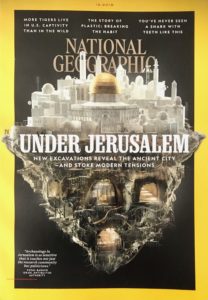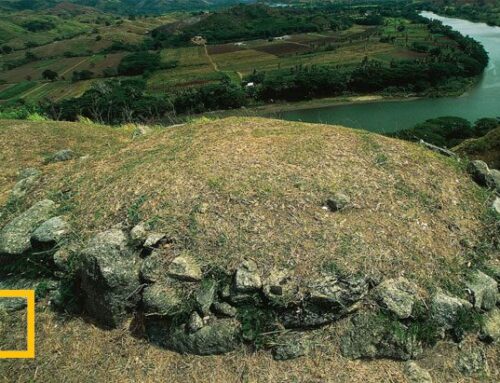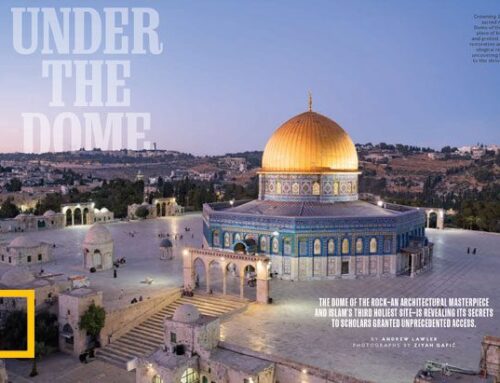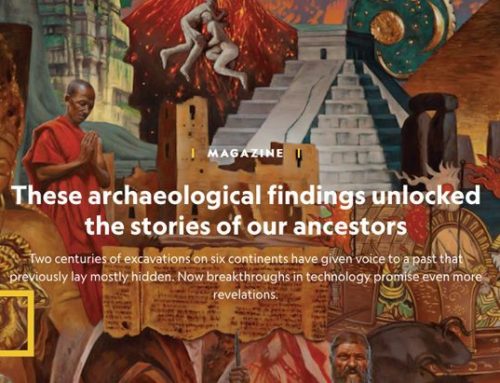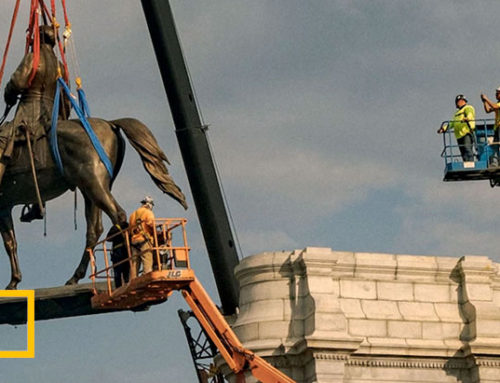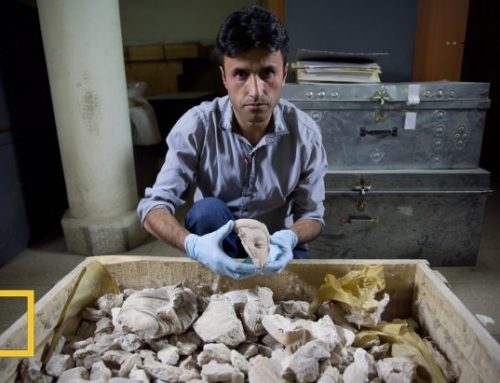 This story appears in the December 2019 issue of National Geographic magazine as the cover story
This story appears in the December 2019 issue of National Geographic magazine as the cover story 
Controversial excavations under the Holy City uncover layers of history and stoke long-standing tensions.
‘Duck down’ is Joe Uziel’s constant refrain.
I’m struggling to keep up with the Israeli archaeologist as he slips his thin frame easily through the twisting and narrow tunnel studded with protruding rock. With only the light of our smartphones to guide us, I bend low to prevent my battered yellow hard hat from scraping the stone overhead. Then he stops abruptly. “I’m going to show you something cool.”
The cramped passage lies beneath a rocky spur of land jutting south from Jerusalem’s Old City. The narrow ridge, the site of early Jerusalem and today packed with houses occupied mostly by Palestinian residents, conceals a subterranean labyrinth of natural caves, Canaanite water channels, Judaean tunnels, and Roman quarries. This particular passage is of more recent vintage than most, having been hewed by two British archaeologists in the 1890s.
I follow Uziel into a recently excavated space that’s the size and height of a comfortable suburban living room. His light picks out a stubby, pale cylinder. “It’s a Byzantine column,” he explains, crouching down to pull back a lumpy sandbag, revealing a smooth white surface. “And this is a portion of the marble floor.”
We are standing in a fifth-century church built to commemorate the site where Jesus is said to have cured a blind man near the Pool of Siloam. The sanctuary fell out of use, its roof eventually collapsed, and the ancient building over time joined the city’s vast underground realm.
For Uziel the church is more than cool. It’s also the latest complication in one of the world’s most expensive and controversial archaeological projects. His mission is to unearth a 2,000-year-old, 2,000-foot-long street that once conveyed pilgrims, merchants, and other visitors to one of the wonders of ancient Palestine: the Jewish Temple. Choked with debris during the fiery destruction of the city by Roman forces in A.D. 70, this monumental path disappeared from view.
“Because of the church, we have to change direction,” says Uziel. “You never know what you are going to hit.” He already has bumped into Jewish ritual baths, a late Roman building, and the foundations of an early Islamic palace. Each has to be mapped and studied, and a detour found or a path made by removing the obstacle or drilling through the impediment.
When the British excavators burrowed their way into the church, tunneling was common. Today, except under special circumstances, it is seen as both dangerous and unscientific. Here, however, excavating from the surface down is impractical, given that people live just yards above. Instead, an army of engineers and construction workers, toiling 16 hours a day in two shifts, is boring a horizontal shaft under the spine of the ridge. As they move forward, Uziel and his team laboriously dig out earth from the top of each newly exposed section to the bottom, retrieving pottery, coins, and other artifacts. Whether this method is scientifically sound depends on which Israeli archaeologist you ask. For some it’s revolutionary; for others it’s deeply misguided.
Tunnel workers battle unstable soil that has led to cave-ins, while residents living above complain of damage to their homes. The ambitious project, funded largely by a Jewish settler organization, is in a particularly sensitive spot in East Jerusalem, the area of the city annexed by Israel in 1967 that much of the world considers occupied territory. (Most excavation in such territory is illegal under international law.) Called Wadi Hilweh by Palestinians, for Jews this is the City of David, the place where King David created the first Israelite capital.
Uziel leads me back through the narrow passage, and we emerge into a completed portion of the new tunnel. In the sudden glare I’m almost clobbered by a plastic bucket filled with earth sailing by on an overhead conveyor belt. Unlike the dark and dank British shaft, this one is braced in shiny steel and resembles a subway line in size and shape. Instead of tracks, however, ancient limestone steps gleam into the distance. “Some of these stones seem virtually untouched,” the archaeologist marvels as we stroll up the broad stairs. “This was the main street of early Roman Jerusalem. Pilgrims purified themselves at the pool and then made their way up to the Temple.”
The path proved short-lived. Unearthed coins suggest that a notorious gentile oversaw construction of the monumental staircase around A.D. 30, a Roman prefect best known for ordering the Crucifixion of Jesus: Pontius Pilate.
“Truth shall spring out of the earth,” say the Psalms, but whose truth is the question that haunts Jerusalem. In a city central to the three great monotheistic faiths, putting a spade into the ground can have immediate and far-reaching consequences. In few places on Earth can an archaeological excavation so quickly spark a riot, threaten a regional war, or set the entire world on edge.
After the Israeli government opened a new exit to an underground passage along a part of the Western Wall in the Old City’s Muslim Quarter in 1996, some 120 people across the region died during violent protests. Subsequent squabbling over who should control what lies beneath the sacred platform that Jews refer to as Har HaBayit (the Temple Mount) and Arabs call Haram al Sharif (the Noble Sanctuary) helped scuttle the Oslo peace accord. Even the recent construction of Jerusalem’s Museum of Tolerance has come under fire for destroying Muslim graves.
“Archaeology in Jerusalem is so sensitive that it touches not just the research community but politicians and the general public,” acknowledges Yuval Baruch of the Israel Antiquities Authority (IAA). Baruch is chief of the IAA’s busy Jerusalem office, and he’s proud of his unofficial title as the mayor of underground Jerusalem. Under his reign the city has become one of the world’s busiest archaeological sites, with around a hundred excavations a year.
Palestinian Authority president Mahmoud Abbas has complained that the constant digging is part of a campaign to overwhelm 1,400 years of Muslim heritage with Jewish finds. “Here archaeology is not merely about scientific knowledge—it is a political science,” adds Yusuf Natsheh, director of Islamic archaeology for the Jerusalem Islamic Waqf, the religious foundation that oversees Jerusalem’s Muslim holy sites.
Baruch hotly denies any bias in what’s excavated. Whether Canaanite or crusader, each era gets its scientific due, he insists. There is no doubt that Israeli archaeologists are among the best trained in the world. Yet there’s also no doubt that archaeology is wielded as a political weapon in the Arab-Israeli conflict, with Israelis having the edge since they control all excavation permits in and around Jerusalem. At a speech in 2011 before the United Nations General Assembly, the Israeli prime minister said he kept in his office a 2,800-year-old signet ring found near the Western Wall inscribed with his family’s adopted surname, Netanyahu, citing it as a physical token of Jerusalem’s Jewish past.
Politics, religion, and archaeology have long been deeply entwined here. Around A.D. 327, Empress Helena presided over the demolition of a Roman temple. “She opened up the earth, scattered the dust, and found three crosses in disarray,” according to a nearly contemporary source. The elderly mother of Constantine the Great, she declared one to be the piece of wood on which Jesus was crucified. What was hailed as the True Cross, the most famous of Christian artifacts, helped spark interest in sacred Christian relics. The Church of the Holy Sepulchre soon rose over the site.
Some 1,500 years later, a French scholar and politician named Louis-Félicien Joseph Caignart de Saulcy launched the city’s first archaeological excavation and sparked another craze. In 1863 he dug out a complex of elaborate tombs, enraging local Jews who filled in at night what his workers exposed in the day. Undeterred, de Saulcy hauled to the Louvre an ancient sarcophagus containing the remains of what he claimed was an early Jewish queen.
Other European explorers arrived to seek their own biblical treasures. In 1867 the British dispatched a young Welshman to probe Jerusalem’s underground terrain. Charles Warren hired local crews to dig deep shafts and tunnels that kept his work from the prying eyes of Ottoman officials who then controlled Jerusalem. When digging proved difficult, he used dynamite to clear pockets of stone. Warren’s astonishing exploits—he once explored a sewage channel by laying old doors across the muck—and his remarkably precise maps are still a wonder. But another legacy may be an enduring mistrust of archaeologists among the city’s Muslims.
A century later, when Israel captured East Jerusalem, including the Old City, from Arab forces during the 1967 Six Day War, Jewish archaeologists launched major scientific excavations that became a centerpiece of the young country’s efforts to prove and celebrate its ancient roots. They unearthed first-century villas of the Jewish elite filled with elegant mosaics and painted walls. But they also exposed parts of the long-lost Nea Church that had been built 500 years later and was second in importance only to the Holy Sepulchre, as well as ruins of an enormous complex constructed by early Muslim rulers.
Some excavations, however, were overtly religious. Only a few segments of the Western Wall—a remnant of Herod the Great’s Temple platform and Judaism’s most sacred site where Jews can pray—are aboveground, so after the Six Day War, the Ministry of Religion began an effort to expose its entire length by digging tunnels. Longer than the Empire State Building is tall, the wall is covered by later buildings along more than half its length. For almost two decades there was little archaeological supervision of the tunnel work, and untold data were lost, says Israeli archaeologist Dan Bahat, who agitated successfully for archaeological control over the digs. The work also fed Muslim suspicions that the real Israeli goal was to penetrate the wall and access the sacred platform.
One summer morning in 1981, just after Raiders of the Lost Ark opened in theaters, those suspicions were confirmed. Guards from the waqf encountered a prominent rabbi knocking down a crusader-era wall that sealed an ancient subterranean gate beneath the sacred platform. The rabbi believed the lost ark was secreted beneath the Dome of the Rock, one of Islam’s oldest and holiest shrines. An underground scuffle ensued, and Israeli prime minister Menachem Begin quickly ordered the gate sealed before the conflict could morph into a full-fledged international crisis.
Fifteen years later, it was the turn of Israeli Jews to express outrage. In 1996 the waqf turned one of Jerusalem’s most impressive underground spaces, an enormous columned hall beneath the southeastern end of the platform known as Solomon’s Stables, from a dusty storeroom into the large Al Marwani Mosque. Three years later, the Israeli prime minister’s office granted a waqf request to open a new exit to ensure crowd safety—Israel controls security on the platform—but without informing the IAA.
Heavy machinery quickly scooped out a vast pit without formal archaeological supervision. “By the time we got wind of it and stopped the work, a huge amount of damage had been done,” recalls the IAA’s Jon Seligman, then in charge of Jerusalem archaeology. Nazmi Al Jubeh, a Palestinian historian and archaeologist at Birzeit University, disagrees. “Nothing was destroyed,” he says. “I was there, monitoring the digging to be sure they did not expose archaeological layers. Before they did, I yelled, ‘Khalas!’ ”—Enough! in Arabic.
Israeli police later hauled the resulting tons of earth away. In 2004 a privately funded sifting project started sorting through the dirt and has so far recovered more than half a million artifacts. When I visit the project’s lab, archaeologist Gabriel Barkay pulls out cardboard boxes containing chunks of colored marble he believes came from courtyards surrounding the Jewish Temple. Seligman and many of his colleagues, however, dismiss the finds as having little value, since they were discovered out of context and might have been deposited on the platform in later periods. “The paradox,” he adds, “was that most of what was destroyed by the waqf was Islamic.”
On a drizzly winter morning I make my way to the entrance of the Western Wall tunnels, just off the plaza dense with men in black hats and coats. Inside is a jumble of underground reception halls, prayer areas, and archaeological excavations. Down the hall from a glass-and-steel synagogue cantilevered within a medieval Islamic religious school are Roman latrines and a recently unearthed small theater—the first found in ancient Jerusalem—built as part of the second-century revival of the city as Aelia Capitolina.
At a plywood door covering a stone arch, I meet Shlomit Weksler-Bdolah. She speaks as fast as she moves. “Come, come. I must get back down,” the IAA archaeologist says as she trots down stairs that smell of freshly sawed wood. In the humid chamber below, three young Arab men in T-shirts casually maneuver a two-ton stone dangling from iron chains. Weksler-Bdolah explains that it’s being moved to give tourists access to what she argues were formal banquet rooms built during the rule of Herod the Great.
“We are standing in the western triclinium”—a Roman term for a dining area with couches—“and the eastern hall is just beyond that passage,” she says while keeping an eye on the gently swaying rock. According to her research, the elegant compound was built in the first century B.C. to wine and dine important visitors in grand fashion. Hidden lead pipes spouted water to create a pleasing ambience.
Weksler-Bdolah excuses herself when an engineer in a white helmet calls out from above. They have a long and heated discussion over a section of yellow plaster that he wants to remove to accommodate a metal stairway for tourists. “This is Roman-era plaster and very unusual,” she says to me in an aside. These are the sort of debates that echo regularly beneath the streets of Jerusalem: What should remain, and what should be sacrificed?
A century and a half of discoveries under Jerusalem have upset old beliefs and dashed cherished myths. Many archaeologists today dismiss the biblical vision of King Solomon’s glittering capital of a large empire. The famous monarch is not even mentioned in any archaeological find of the era. Early Jerusalem was more likely a minor fortified hill town. Nor did the arrival of Islam in the seventh century A.D. suddenly displace Christianity, as historians long assumed. Many excavations show little change in the day-to-day life of Christian residents.
Yet the digs have unearthed clay seal impressions bearing the names of biblical courtiers, lending credibility to their existence. Archaeological work also backs Empress Helena’s assertion that Jesus was crucified and buried on land that is within what is now the Church of the Holy Sepulchre. And archaeologist Eilat Mazar of the Hebrew University of Jerusalem even claims to have found the palace of King David, the first Israelite ruler of Jerusalem.
One quiet Saturday morning, the Jewish Sabbath, I run into Mazar as she wanders through the otherwise deserted City of David park. On the northeastern edge of the narrow ridge, she excavated a building with thick walls next to an impressive stepped stone structure that braces the steep slope. Based on the pottery she found, Mazar dates the building to around 1000 B.C.—the traditional date assigned to the Israelite takeover of Jebusite Jerusalem.
She is so deep in thought that I have to call her name twice to bring her out of her reverie. “I like to come here when it is quiet to think,” she explains. She invites me down steps that lead to a metal catwalk above her famous excavation. She leans over the rail and points at the rubble below. “This was an extension of the old Canaanite palace, but the building is something new. This is a king with a vision, who built something large and impressive in a skilled manner.” For Mazar, that can only be King David. “Everything fits the story in the Bible.”
Her 2005 discovery made headlines around the world, but colleagues remain mostly unconvinced. She relies heavily on pottery for dating, rather than more modern methods such as radiocarbon, and her literal reading of the Bible is seen by many archaeologists as flawed. Even the sign on the catwalk adds a question mark to the identification of the site: “The remains of King David’s palace?”
“I rely on facts,” she says, a touch of irritation in her voice when I raise the objections of other academics. “What people believe is a different story. It takes time for people to accept what’s new. I can’t wait.”
Mazar is eager to dig just to the north, where she believes the famous palace of David’s son, Solomon, lies hidden. “I am sure it is there,” she says with a sudden fierceness. “We need to excavate this!”
She’s preparing a request for permission to dig the site. Whether the IAA will approve her further excavation is in question. “Today, if you dig, you need solid data—not just coins or pottery, but results using physics and biology,” says the IAA’s Baruch. “Eilat Mazar is not playing in this game.”
Across the street from Mazar’s putative palace of David, Yuval Gadot epitomizes this new game. The tall and affable Tel Aviv University archaeologist once opposed Israeli digs in this overwhelmingly Palestinian neighborhood, but the opportunity to lead the city’s largest recent excavation proved too tempting to refuse. What once was a dusty parking lot is now an enormous pit open to the sky, encompassing much of the city’s past 2,600 years, from early Islamic workshops and a Roman villa to impressive Iron Age buildings predating the Babylonian destruction of 586 B.C. Much of the work takes place in off-site labs, where specialists analyze everything from ancient parasites in Islamic cesspits to intricate gold jewelry from the days of Greek rule.
Soon the excavation will open to the public, beneath a large new visitors center to accommodate the increasing hordes of tourists. Gadot, Mazar, and Uziel have helped turn this quiet Arab village into one of Israel’s most popular attractions in a city rated among the world’s fastest growing tourist destinations. At night their archaeological sites serve as dramatic backdrops for laser light shows.
“Here it began, and here it continues,” thunders the narrator amid colored lights and swelling music. “The return to Zion!”
The organization behind this effort is the City of David Foundation. Created by former Israeli military commander David Be’eri in the 1980s to establish a strong Jewish presence, it has funded the lion’s share of recent archaeology here. Along with deep pockets provided by foreign and Israeli donors, the group boasts excellent political connections. At a lavish ceremony last June, U.S. ambassador David Friedman swung a hammer to break a wall, inaugurating the first segment of Uziel’s tunnel. “This is the truth,” he said of the ancient street. The White House Middle East envoy called Palestinian criticism of the event “ludicrous.”
When I meet with the foundation’s vice president, Doron Spielman, he is bullish about the future. “If the next 10 years are like the last 10 years, this will be the number one archaeological spot in the world,” says the Jewish native of the Detroit suburbs. Spielman expects the visitor tally to nearly quadruple to two million in a decade. “There is a fascination for a people who have existed for thousands of years,” he says. “This isn’t like an Akkadian site. The people who began here are still here.”
In his telling, the development helps everyone. “People buy their Popsicles and drinks from Arab stores,” he says. “And there is a lot of security that benefits both Arabs and Jews.” He is also optimistic about the impact of Jewish residents, who now number about one in 10 and who live largely in gated compounds patrolled by armed guards. “You will see this as a model of coexistence. People will be living together within an active archaeology site with a lot of opportunity.”
That’s not how Abd Yusuf, a burly local shopkeeper, sees it. “Business is terrible!” he tells me, as he sits amid Jerusalem-themed knickknacks. “We used to have so many tourists, but now no one comes. They take all the tourists to their shops,” he adds, referring to the City of David’s concessions. Then he points to cracks in his wall. “I have had to replace my door three times because the earth shifts beneath.”
Just up the street, I pay a visit to Sahar Abbasi, an English teacher who also works as deputy director at the Wadi Hilweh Information Center, a Palestinian organization housed in a modest storefront. “The excavations pose many challenges,” she says. “Our homes are being damaged and destroyed.” She estimates that 40 houses have been affected, half of them severely, while five families have been evicted from dwellings considered unsafe.
“If they can’t control us from above, they start to control us from below,” Abbasi adds.
One morning, off a narrow alley above Uziel’s tunnel, Arafat Hamad welcomes me into his courtyard studded with lemon trees. A retired barber, Hamad has short silver hair and a fast smile that fades quickly. “I built this house in 1964 with a thick concrete foundation, but look what has happened in the past couple of years,” he says, pointing to wide cracks that creep up to just below the first-floor windows. Taking me around to the side of the house, Hamad points to piles of rubble. “One evening last August we were sitting on the porch when the house began to shake,” he recalls. “We could hear them working below with heavy machinery. If you put your hand to the floor, you could feel the vibrations. We fled the house to neighbors’, and then we heard a bang—and we could see the cloud of dust rising from where our outdoor kitchen had been.”
Across the street, Hamad’s neighbor, an older woman named Miriam Bashir, doesn’t seem happy to see me. “I’m fed up with journalists,” she says. “I just want to be left alone. We are lost. We don’t know what to do!”
After a few minutes she relents and agrees to show me the damage to her interior walls. “The cracks began three years ago, but they became more obvious in the past year and a half,” she says. As I say goodbye to Bashir at her gate, she smiles for the first time. “I would like you to relate our story in an honest and clear way. We are peaceful people who live here, and we will stay here despite the damage.”
When I spoke with Spielman, he dismissed the concerns of Arab residents. “Yes, we are working under people’s homes, which is not an issue if it is engineered well, which it is.”
Three days after my visit to the Palestinians, Spielman sent a chilly email warning me against providing a stage for “the claims of politically motivated, anti-Israel, special interest groups.” He requested that I supply in writing the details of any “nefarious claims” before publication. My repeated attempts to speak again with him and other City of David officials were met with silence. The waqf’s Natsheh is not so reticent. For him the excavations and attempts to displace Palestinians are intimately connected. “Archaeology should not be a tool for justifying occupation,” he says.
What lies beneath Jerusalem reveals that the city’s history is too rich and complicated to fit any single narrative, whether Jewish, Christian, or Muslim. Helena failed to wipe away its pagan past, just as the Romans fell short of annihilating the rebellious Judaean capital and Muslims couldn’t remove all traces of the hated crusader occupation. No matter who is in charge of this most contested of places, evidence from the past inevitably will surface, challenging any story tailored to a narrow political or religious agenda.
“Everyone who ruled Jerusalem did the same thing: built his tower and hoisted his flag,” says Weksler-Bdolah with a laugh, taking the long view demanded by this venerable and violent place. “But I think it is stronger than all those who try to control it. No one can completely erase what came before.”
